
Anne Laurel Carter.
Profile by Dave Jenkinson.
 When Anne was born in Don Mills, ON, on September 22, 1953, she was then the youngest of three children. "I have an older sister and an older brother. I really grew up as the youngest of the family, and then 10 years later my mom had a 'surprise' boy. He's my rascally little red-headed brother Jim who is the little brother in Under a Prairie Sky. He got into a lot of mischief."
When Anne was born in Don Mills, ON, on September 22, 1953, she was then the youngest of three children. "I have an older sister and an older brother. I really grew up as the youngest of the family, and then 10 years later my mom had a 'surprise' boy. He's my rascally little red-headed brother Jim who is the little brother in Under a Prairie Sky. He got into a lot of mischief."
"As a child, I wanted to be an actress. I remember telling my minister about that career choice when I was about five years old, but I was far too shy to ever be an actor. In school, I never ever went and tried out for a play. We didn't do public speaking in school, and kids didn't get up and give presentations. As a teenager, I wanted to be a paediatrician. I saw Ingrid Bergman in The Inn of the Sixth Happiness in which she was a missionary doctor in China. That movie just knocked me off my feet. I thought, 'OK, I'm going to be a doctor.'"
Following high school, Anne entered the University of Toronto with medicine as her goal. "In grade 12, I had dropped everything I was good at, like history and languages (I was taking German, Latin and French) and took all the sciences, something I never should have done. I didn't do very well in my sciences program at university. I was really awful and dropped out in second year and went off to Israel. I had gone to a kibbutz in Israel for three months during the summer I was 17. I had a lot of Jewish friends, and, for me, Israel was the spiritual centre of the world, and so I wanted to see it. I probably did have a love of history, but I didn't know it. My body was moving before my brain had engaged, and so I went back to Israel and stayed for a year and a half through the Yom Kippur War in 1973. I did 'ulpan' which is a kibbutz Hebrew study. I always loved languages. Israel was, and is, an extremely dynamic country, and so it fascinated me as did kibbutz living. There were young people who came from all over the world from the diaspora."
After Israel, Anne went to California. "I had fallen in love with someone whom I met in Israel. We lived in California, got married and stayed in California for a year and a half before coming up and settling in Toronto. It was a young marriage that lasted a couple of years. I finished my BA from York in 1975 and then my B.Ed. at the University of Toronto in 1979. I had dropped French in high school, but I still wanted to learn it. I found out that, as an adult, you could study in Quebec on summer immersion programs, and so I did that for five summers. I went to Trois Pistoles, St. Pierre and Miquelon, Riviere de Loups, Chicoutimi and Grenoble in France."
Since learning French had led to an interest in living and teaching in Quebec, Anne went and taught up north on the Quebec side of James Bay. "I was teaching English as a Second Language, something I had taken as part of my B.Ed. That was a very difficult experience. I was in Eastmain, a tiny little isolated village, and you had to fly in. Living with isolation was a new experience. I was teaching English to James Bay Cree. I was in Eastmain for a year, and then I went to Mistissini which is in north central Quebec. It's accessible by road, if you can call it that. I was there for a year, and then I went up to Chisasibi where the high school was."
"It was during this period that I had major hip surgery. I have hip displasia. Interestingly, doing all these presentations to kids in schools makes you really look at what inspired your stories. I hadn't realized the connection between In the Clear and being in a body cast for nine weeks unable to move. The surgeons had reconstructed one of my hips. During the surgery, my sciatic nerve was damaged, and I was in terrible pain. I lost almost 40 lbs. and weighed 100 lbs when I got out of the cast. I couldn't walk, and I spent two or three months in a wheel chair. In a way, my experience paralleled, not being in an iron lung, but the whole experience of being immobile. As well, there was the pain connection. Polio was extremely painful because the nerves that tell you what hurts don't get affected."
"Kids have asked me about In the Clear. 'Why did you pick polio? Did you have polio?' And I answer, 'No, I didn't.' It's funny, you know, the connections between the unconscious mind and where creative work comes from. You're not conscious of these things when you write them. Or I'm not. I don't write consciously. I very much write from the heart and the spirit. When I work with kids, I ask the leading question, 'What is the disease you're most afraid of getting now?' and their answers almost always involve some kind of cancer. Then I ask them to imagine being parents 30 years from now when one of their children comes home and says, 'Mom? Dad? I just read this book about this girl who gets...do you pronounce it can-sir?' Because there's been a cure at some point in those 30 years, their children won't know about cancer, and it will be strange for them, as adults, that their children will not know about cancer. That's it's for me when kids today have never heard of polio."
"After teaching up north, I came back and got my M.Ed. in second language learning from O.I.S.E. in 1984, and then I went out to Peterborough and taught. Craig, my husband, and I have been friends since we were 20. He'll tell you that he always carried a torch for me, and so he waited. He was in Toronto and came out to Peterborough and wooed me. I came back and got a job in Bramalea with the Peel School Board, and then we got married and had kids right away."
"I never wanted to be a writer when I was a kid. It was never in my vocabulary. I had never met a writer.The only thing I ever saw my dad read was the newspaper. He was an accountant. Nevertheless, I loved reading, and I took my first children's literature course that was offered in grade 13. I also took children's literature at York when I finished my BA. I took it again when I did my Master's, and so I must have always had an interest. I hadn't read The Secret Garden or The Lion, The Witch and The Wardrobe as a kid, and it was wonderful. The child inside me came alive when I read those books. When I had my own kids, I read picture books to them and thought, 'These are the most beautiful things.' It's pure poetry when something's really good, and I was inspired to try and do it. I had a story idea that came from one of my kids who was having a problem, and I tried to write a story for the first time. It was that 'click' of having the idea and writing it down. I always tell kids, 'You've got to get it out of your head and down on paper.'"
"I submitted all my early stories, and I have that binder full of rejection letters that most writers talk about. I remember sending my first story out and waiting a few months. It was somewhere between a picture book and an early chapter novel. They sent me back the 'form' letter that begins, 'Dear Author,' and I was totally devastated. It took me a little while, but then I got mad. A Toronto writer, Wason Choy, has this wonderful phrase, 'Never surrender,' and that's the advice I gave myself. 'What? They don't like it? Just wait. I'm going to find out how to write this so that they do like it.'''
"As well, I'm an obsessive, perfectionist kind of person, and so I thought, 'I'm going to learn how to write a story,' and I started taking creative writing classes and found my way to Peter Carver and his classes which are wonderful. Peter loves story, and he knows a lot about it. He must have been a wonderful high school teacher because he knows how to foster a positive and encouraging learning environment."
"I kept submitting. In 1996, I wrote my mom's story about her brother, Jim. She had four older brothers, and, of course, the one she was closest to is the one who didn't come back from the Second World War. My mom cries every time she talks about Jim. I write with a lot of emotion. I actually wrote the story with my mother's name, Ruth, and his, Jim, and then I made up a whole bunch of things, although the part about the ring turned out to be true. 'No Missing Parts' was my first short story, and I sent it to the Toronto Star contest in 1997 and won second prize. That was all the encouragement I needed. I didn't look back from that point on. I remember reading that story in Peter's class, and the woman sitting next to me started crying. The following year, 'Leaving the Iron Lung,' another short story, came second in the Star contest. I revised it and sent it to Prairie Fire who accepted it. That story won the Vicky Metcalf Award which also meant a lot because the certificate says something about 'inspirational writing for young people,' and in the down times I remember that."
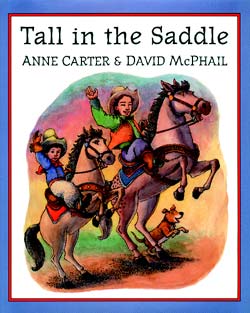
"Around the same time, Orca accepted the manuscript for Tall in the Saddle. Getting my first phone call for a book was a huge moment. I remember my excitement getting off the phone. We had a circular route between the kitchen, living room and dining room, and I ran around and around. My kids started following me, asking, 'Mom, what's going on? What are you so excited about?' And I replied, 'I got a phone call from Orca. They're going to publish Tall in the Saddle, my first book.' The kids were so excited. I feel very fortunate because I've talked to a lot of writers who don't have support from their spouse or family. My family's just great. It's almost like we're doing it together."
While Anne had moved to part-time teaching when her first child was born, after the birth of her third, she stopped teaching completely. "I had the plum grade one French immersion job in Toronto. It was a fantastic job, but then I went and saw Les Miserables. There's a song or scene in it where Jean Valjean decides that he has to go and take care of the orphan Cosette. I had a dream that night, and when I woke up, I said, 'I can't go back to work and call myself an educator. I have to stay home with my children. Children need somebody there.' That's how I felt, and Craig and I talked about it and decided I would stay home. Then, when the children were older and I was ready to go back teaching again, we decided I'd give writing a try. If I hadn't had anything published within five years, writing wasn't meant to be. I had been trying all kinds of things. I still studied piano, and I was taking art classes and making stained glass windows. I took a decoy class and made decoys. There was some artistic yearning within me, and writing seemed to answer the call."
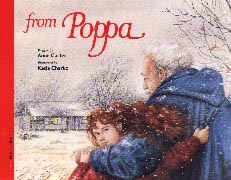
"Lobster Press brought out From Poppa in the same year that Tall in the Saddle appeared. Anne Featherstone at Orca had looked at the manuscript for From Poppa,and she really loved it, but, because of Orca's having published Sheryl McFarlane's Waiting for Whales, they didn't want to do another grandparent loss story at the time. From Poppa, with its resurrection idea, is actually very religious. Amazingly, the wood duck's scientific name is Aix sponsa which means 'the promised one.' When I was working on the idea for the book, a friend phoned me and said, 'Anne, there's a wood duck sitting in a branch of the tree in my back yard. Something wonderful's going to happen.' I'd never heard of that belief before, and something wonderful did happen for her."
"Originally, From Poppa was about a boy who had a problem. He took it to his grandfather, and somehow in making decoys this problem would get solved. Well, I must have written that idea about a hundred different ways, and it gradually evolved. When I do school presentations, I tell the kids, 'Writers always tell you to write what you know, but you can also write what you don't know because I never had a grandfather that I was close to.' As a child, I envied every kid I saw who went off to Grandma and Grandpa's and was taken everywhere with these wonderful grandparents. I didn't have that, and so that grandfather in From Poppa was the grandfather of my longing."
The perfect grandfather is not the only ideal relative that Anne has created. "I wish I had an aunt like In the Clear's Tante Marie. When I was a teenage girl, I had 'second mothers.' You know how teenagers often have a second home or whatever; well, I did as a teenager, but not as a young girl. I wished I'd had someone then as you desperately need an adult who is mentoring you. I think that's a wonderful figure to have as a child."
"I have no idea where Tall in the Saddle came from. I've always been a closet poet, and that story was poetic. It's about my husband going off to work and the kids, when they were little, saying goodbye. You know how small kids have no idea what Mom and Dad do when they go off to work. I thought, 'They would see him continuing to be a cowboy because they'd just been playing cowboys. They'd see him go off on the bus and the traffic going down Yonge Street.' I have a very strong visual impression of my stories as I write them, and so the cars would turn into cattle. Since the kids would play cowboys all day, when Dad comes home, the play would continue. I wish I could be an artist because there'd be these funny little clues like dust on Dad's clothes, and he'd be wearing a suit, but he'd still have the red bandanna on, and so the reader would have to stop and wonder, 'Ah, maybe he was a cowboy.'"
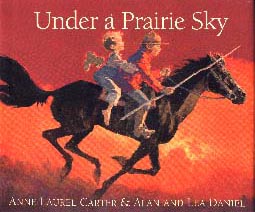
Under a Prairie Sky actually began with Anne's receiving a phone call from Orca. "Anne Featherstone phoned me and said, 'Do you think you could write a story in the style of Tall in the Saddle, something to do with the Mounties?' And I said, 'Well, yeh.' She asked, 'Do you like horses?' and I loved horses and always wanted one. My grandfather was a big trainer back in the Thirties. He won the Queen's Plate six times. His picture's up at Woodbine Race Track. I'd always loved horses. Once again that's right out of my longing. The little boy in there is very much my younger brother, Jim. I had just heard Jean Little speak about tapping into your memories, to go back and evoke your most powerful childhood material and then it's easier to write, not easy, but that's where you write from. You've got to remember it and re-live it. And so I remembered looking after my little brother. And you love him, but God he drives you nuts."
"Apparently Alan and Lea Daniel had loved the story in Under a Prairie Sky and went out on location to take pictures and sketch. I think their more realistic kind of illustrations are exactly right. As a child, I didn't want to be a Mountie, but, as a kid, whenever you saw Mounties at something like the musical ride, it was just so awesome. I have a friend, an elderly woman, who is from Saskatchewan. I went to her place and interviewed her. Then I did a free association thing, all of my ideas about the Prairies, what I loved, and what she loved. The story flowed out in the same kind of free verse as in Tall in the Saddle. As well, when I was a child, we travelled across Canada. I remember the first time I saw the Prairies and the landscape going on forever. It makes a huge impression, and it's not only flat but is quite varied. The central character in Under a Prairie Sky was a girl to me when I wrote it. That was me. But that's not the way the Daniels saw it, and the publisher liked it better, and it works great having it be a boy."
"I did a writing course with Deirdre Baker which was fantastic, and Deirdre talked about how we're getting into these lengthier picture books. My goal is to write the younger picture book which is much shorter and very tight, more in the classic style of Margaret Wise Brown's Goodnight Moon. If I could write something like that, I'd be thrilled. But I think that to do that it helps to spend a lot of time around little kids. I wrote my first picture books when my kids were younger, and they're getting older. It's an interesting dynamic, and I wonder if this has happened to other kids writers. I'm writing work that parallels what my children are reading and living and doing because I'm making conscious observations and unconscious connections about what's going on in their lives and my story world."
"For example, I'm trying to write the sequel to Bless This House. Well, in this sequel, the big thing that's going on is that the three girls don't get along. Elizabeth, who's a really nice girl, gets along with Mathilde, the Acadian girl, and with Sarah, the stuck-up one. I've been watching my daughter, Katie, who is in grade 5, the same age as my characters, dealing with this issue which is troublesome for girls of this age. Three often have trouble being friends, and they can be nasty to each other. I'm trying to write my sequel, and my girls are fighting all the time. I keep thinking, 'How am I going to resolve this? What is Elizabeth going to do?' I know the answer, but I haven't quite understood how to write it. You don't want to read scene after scene of these girls fighting."
Anne's next book with Orca is a story in rhyme called The F Team. Anne says that "it's about hockey and kids trying out for competitive teams. The story's actually inspired by my eldest son who wanted desperately to make the A team. He took and loved figure skating. In the story, the F team consists of six klutzes who don't make the A team because the team's already been picked. The A team players are nasty. The six klutzes, the rejects, form the F team and learn figure skating and then challenge the A team to a game of hockey. I had such fun writing it, but it was a challenge to make it scan properly without shoehorning the rhymes. It's an emotionally true kids' story. Plus there's the 'F' word which I play on. Every kid knows the 'F' word. When I talk about it in school, I naively ask, 'The 'F' team? What could the 'F' team stand for?' And the kids give me words like 'fun' and 'fantastic' and 'far out.'"

"I'm working on a fantasy with a male and a female protagonist. It is tough to get into a boy's head and to think like a boy. I had to do that in The Girl on Evangeline Beach. Michael, the central character, came to me, and I don't know if I got him or not, but certainly I was constantly 'in' his head and hopefully thinking like him. Nevertheless, I'd ask my husband and my sons, 'How would you react if...?' or 'What do you think when you look at a girl and you're interested in her?' I knew the answers, but I still had to check."
Anne has now had two novels published which focus on the expulsion of the Acadians, the first being The Girl on Evangeline Beach and the second, Bless This House. Says Anne, "I love Acadian history, and it's not told enough or well. We certainly weren't taught it correctly in school. I firmly believe the English stole the Acadians' lands. After being expelled, the Acadians went on with their lives. They constantly re-sought their homeland, like the Louisiana marshlands area. I find it very interesting how landscape affects a people and what they do. I find theirs an inspiring story, and it's a story of occupation."
The novel In the Clear had its origins in the short story "Leaving the Iron Lung." "I just worked and worked and worked on that short story. I must have revised it a hundred and fifty times. I always loved Pauline - she was vivid in my mind. After I won the Vicky Metcalf Award, I thought, 'OK, I don't really know what it was like for Pauline when she had polio. I don't know that happened to her. And why is her mother so overprotective? What did her aunt do? Maybe her aunt had a role when Pauline got polio.' And so I started doing research."
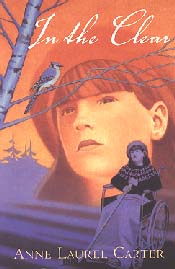
"The novel is dedicated to two ladies, and one of them is a wonderful librarian in Etobico, Janet Abernathy. I love librarians. I was asking her for research help about Acadians which she was providing to me, and I said, 'By the way, Janet, when we're finished, I'm thinking about turning my short story about a girl who had polio into a novel. I've been doing all this research, read everything there is to read about polio, but I need to meet women who had polio in the Fifties and who spent time in an iron lung. Got any ideas?'"
"Janet stood up at her desk, got a little teary, and said. 'Well, you could talk to me. I had polio when I was six, and I spent nine months in an iron lung. I remember my dad putting me in the back seat of the car and driving me down to Toronto when I was feverish. We pulled up University Avenue and stopped at a big building, and I looked up. It was the end of August, and school was just about to start. Because I was a good reader, I looked up and could read "Sick Kids." I didn't know that last word, but I could sound it out.' That's in the book. Janet told me all kinds of other anecdotes. Mary Richardson, the other person to whom In the Clear is dedicated, has been in a wheel chair and paralysed. Her lungs are still affected. She's the most lovely, positive woman."
While Anne did not interview medical personnel from the period, she did read a lot including A Summer Plague. "I read interviews with people who had had polio. The tough nurses mostly came from the first person narratives that I read. Mary didn't have bad experiences although Janet had some experiences with a physiotherapist putting on those scalding hot towels."
"I can't stand it in writing workshops when people say, 'The protagonist has to solve the problem totally.' In one of Peter Carver's classes, we had a lovely Korean man who said, 'That's such a North American concept. In other parts of the world, adults are allowed to share some wisdom with younger people or have a mentoring role.' I gave a presentation to a grade five class in Nova Scotia last year where all the students had read In the Clear. A boy came up afterwards and said, 'I am so glad you didn't have Pauline figure out or get rid of Witch Wilson because what kid could do that? I was waiting for you to do that, and that would have been so predictable. I'm glad that you didn't.'"
Some adolescent and adult readers of In the Clear may perceive that there was or perhaps is some chemistry between Tante Marie and Pauline's father. Anne acknowledges that "there's a short story version in which that was a much stronger aspect, and I'm sure it was Orca's Anne Featherstone who suggested taking it out. She wrote me pages of notes about making the story younger, making it more appropriate, and focussing on Pauline. But there's definitely something there between the two. If I was going to make it an adult short story, it would have come out that way."
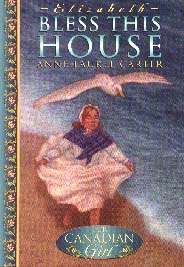
Anne explains that Bless This House flowed naturally from the research she did for The Girl on Evangeline Beach. "When I was in Nova Scotia, I had found out that in 1762, seven years after the deportation, 62 prisoners are documented as being in Fort Edward which is near present day Windsor, NS. Historians don't know how or why they came there. Maybe they were Acadians who'd tried to come back, and, if they tried to come back, they were thrown in prison again and deported again. But historians do know that they were used to repair the dikes and help the new Planters get their crops in. There is some conflict about whether they were slave labour or were properly paid or were just used as prisoners of war to repair the dikes. So that was the historical setting. I thought, 'What if this Planter girl, Elizabeth, came and met this Acadian girl and wanted to help her? Of course, she'd feel sympathetic. What would you feel like if you were given 'occupied' territory, someone else's homeland, but you're brought in as an immigrant and given their land. It's not really your fault, but how would you feel?' A very interesting question to me was, 'How would you feel meeting them face to face?' I think most people would feel guilty and torn but sympathetic. The Planters were devout Christians as well as ordinary hard working farmers."
Bless This House came about because "my agent, Leona Trainer of the Transatlantic Literary Agency, asked for a submission. Leona was a key part of the 'Our Canadian Girl' series happening. I sought an agent after my fifth or sixth contract as I was frustrated with contracts. I do believe, however, that the contract process is an important experience for a new writer. It really slopes your learning curve. Too many writers think they have to get an agent immediately. It's a dream I guess."
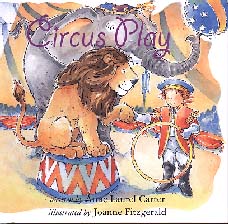
Circus Play, another picture book, began with a chance encounter. "I met Nisha Ferguson at Toronto's Gardiner Museum of Ceramic Arts. I went to the opening of some circus sculptures, and there were three people in circus costumes talking about their sculptures. I went up to one of them afterwards and said, 'You must love the circus.' And she replied, 'Yes, I do. I love it so much I have formed an all-women's trapeze group.' And I said, 'Oh,' and she added, 'Yes, I have a trapeze hanging from the ceiling in my living room.' And I said, 'OH!' It was like a Bob Munsch moment. 'Could I come over and visit you?' I asked. And she replied, 'Yes, and bring your kids if you have any' which I did. The story just happened. Nisha and her son lived in the west end of Toronto in the warehouse-apartments where many artists live. The spaces have high ceilings, and that's where Nisha performed. She has several trapezes. I loved the moves the women did, the poetry, and the names of the moves, 'Shoot the Moon' and 'Banana Split.' My daughter and Nisha's son went into the costume box and dressed up and played circus play."
No Missing Parts And Other Stories About Real Princesses consists of 10 stories, although one of them, "One Mighty Kiss," is presented in a poetic form. According to Anne, the stories in No Missing Parts were written over a period of five or six years. In describing the stories' origins, Anne acknowledges that "'Badlands' is actually one of my favourite stories. I was a teacher and have walked into a classroom and faced 18 boys like my fictional Sybil did. I like boys with problems. They are usually interesting, often creative, and challenge you to be a better teacher. Some are not cut out for school and sitting quietly in a chair. The idea for the chores alternatives to the writing of lines I got from my own boys who are very bright but very fidgety. They'd come home from school and curse and curse at their punishment - the writing of lines. And I would too. It would infuriate me. What a total waste of time! It would be slightly more palatable if there were an educational purpose like having to do 10 lines in Latin and then translate it into French."
Another of the collection's stories, "Far From Home: Marie Robichaud's Journal" was actually a story that Anne had known for some time because it continues the plot of her first novel. "I had the whole sequel to The Girl on Evangeline Beach all written in my mind before the first book even got published. I love Marie's story. I bought some paintings of what were to me Marie and Francois, and they used to fall off the wall. I honestly felt like Marie's ghost was saying, 'Hurry up! Tell my story!' I did all this research about her, and I desperately wanted to follow her story, her going to England, living in the prisons there, and then going to France and to Louisiana and finally 35 years later going 'home' to New Brunswick. Home for Marie would always be Nova Scotia, but she at least would be safe in New Brunswick."
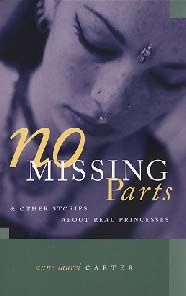
The story, "Saying Goodbye to Princess Di," had dual origins. "Worrying about my weight for one thing, and the desire to write a lighter story. When Princess Di was killed, I did not stay up all night to watch it, but my friends and their daughters did. The event was huge, and her photo was so everywhere that I remember the strange sensation, wondering, 'How can she be dead?' I know she's been written about ad nauseum, but, because No Missing Parts was a book about young women and Princess Di represented someone beautiful yet tormented, I found her a fascinating, important character. She also represents the whole princess trip. I didn't purposely set out to write about princesses. The foreword concerning princesses came after the stories were written when my editor, Peter Carver, said, 'Why don't you try to write a few words as a foreword?' That's when I realized that growing up female has been the strongest thing that has affected my human experience. Having a daughter and thinking about young women, I realized I had written my stories for young women."
The collection's closing story, "Skating Home," was about AIDS according to Anne. "I was driving along, listening to CBC. They were interviewing a 17-year-old girl who had been tested for AIDS, and she would not go and get her results. I started crying. At the time, I was doing some volunteer work for the Teresa Group that helps people who have AIDS, parents and kids. I started to cry and had to pull over. I was thinking, 'But you have to go and get your results.' In the volunteer training for the Teresa Group, one of the things that they had you do was put yourself in the shoes of someone with AIDS. This was a number of years ago when having AIDS carried much more of a stigma and people wouldn't touch you or kiss you or hug you. Imagine what it was like. You start losing parts of your life. Perhaps that's why I had the girl in my story lose some body parts, her toes. Who knows? I had fallen through the ice once when I was twelve, and it came into the story. Mostly, I wanted Tess, my story's character, to go and get her results, but I chose to leave it open-ended. I didn't want 'Skating Home' to be 'educational,' although there is information in the story because you should go and get your results quickly to start treatment."
Forthcoming titles from Anne include another picture book from Red Deer Press which Anne hopes will be illustrated by the Daniels. "The story just sort of happened. It's set in Mahone Bay, Nova Scotia. I was visiting a very good friend there. We were out walking, and her daughter told me about this big move they had made from the west coast and the three promises her mother had made to entice her to move from one coast to the other. There was no way she was going to budge except for the three promises. And so I wrote this very realistic story."
"I also have a fantasy that I've started that I love. Fantasy, much more than time travel, is my genre. I've just read Ursula le Guin's 'Earthsea' trilogy and loved it. I've only written the first two chapters of my fantasy. I have a weird setting and two neat characters, but I haven't got the world figured out. With historical fiction, when you do all the historical research, the big events and the setting surrounding the story are given to you. But it's not the same with fantasy. You've got to figure it all out. I look at really good fantasy writers, and they draw things like a map and family trees, but that kind of thing is hard for me. I have to really work at those details."
Readers may have noticed that Anne used only one of her given names when she began her writing career, but she has since added her middle name, Laurel. Her reason for doing so was quite pragmatic. "I was on the CCBC Book Week Festival in Saskatchewan. This was when I just had the two picture books, Tall in the Saddle and From Poppa. I'd go into these schools, and they'd have 30 books on display by Anne Carter. The problem was that I'd only written two of them. The rest of them were by the American Ann Carter who, among other things, wrote the 'It's Great to Read' series."
In talking about herself as a writer, Anne says, "I love short stories. Alice Munro talks about how it's much easier to write short stories when you're a mother because of the time factor and not being interrupted. When I wrote the novel In the Clear, I had no idea about the passage of time. I didn't make dinner. The laundry wasn't done. One of my boys told his paediatrician that his big wish in life was that his mother would not be on the computer when he came home. When I worked on that novel, I lived in that world. It was hard to come in and out. I was dying to get through the novel, and I'd get totally immersed in it. With In the Clear, the story came out of me easily. It was like pouring something, and you want to just keep pouring, and you don't want it to stop either. It's very hard, and it's draining."
"I used to be a disciplined writer, and I used to write 12 hours a day. I'd write through the weekend. We took the kids to Disney World in Florida, and I hate crowds. This was the 'big' trip, and I said, 'Kids, your mother will be with you once in your lifetimes in a place like this.' I did one day, and my husband was wonderful. He took the four kids to Disney World for two days and let me write. When I'm in an idea, I would rather write than do anything else."
"I actually haven't written much since March, 2001. We were in a serious car accident. This last year has been a year of assessing things. I'm doing a Buddhist meditation course. I ask myself, 'How am I going to write and enter the demanding world of a novel again?' I don't know the answer yet because I'm balancing everything in my life now rather than just being in the world of my writing obsessively. I used to get up at four in the morning and write because it was quiet and I'd be undisturbed. Now, I'm looking for more balance and not getting so obsessed about my created worlds. I was really a Type A kind of person, and so is Craig. I'm now learning to recognize what causes stress. I'm spending a lot more time with the kids, at their games, walking, driving more carefully, and smelling the roses. Yet I do wonder: 'Where am I going to find time to write my novels again? How am I going to do it?' My life since the car accident, since March, 2001, is a gift. I don't know the answers. I work when I can. I'm starting back to work on new things like the sequel for Bless This House, and I've got the fantasy started, and I have another novel half way through that I hope I can get back to."
Books by Anne Laurel Carter.
This article is based on an interview conducted in Toronto on June 15, 2002.
